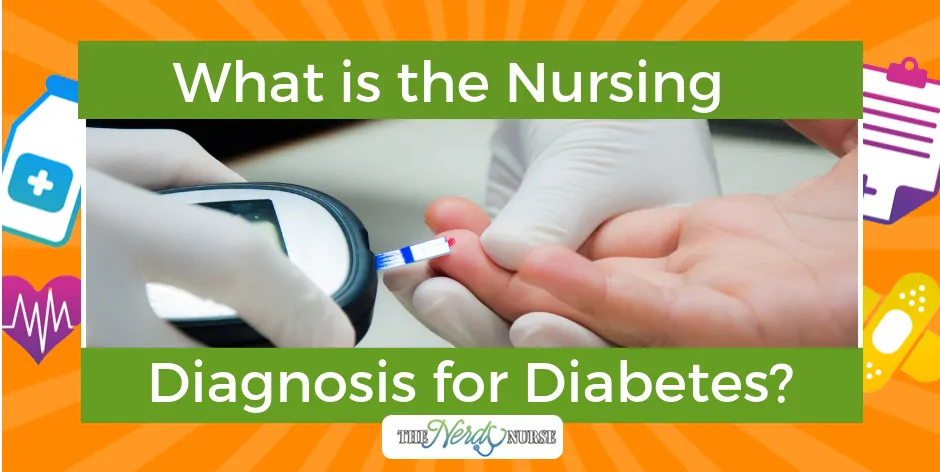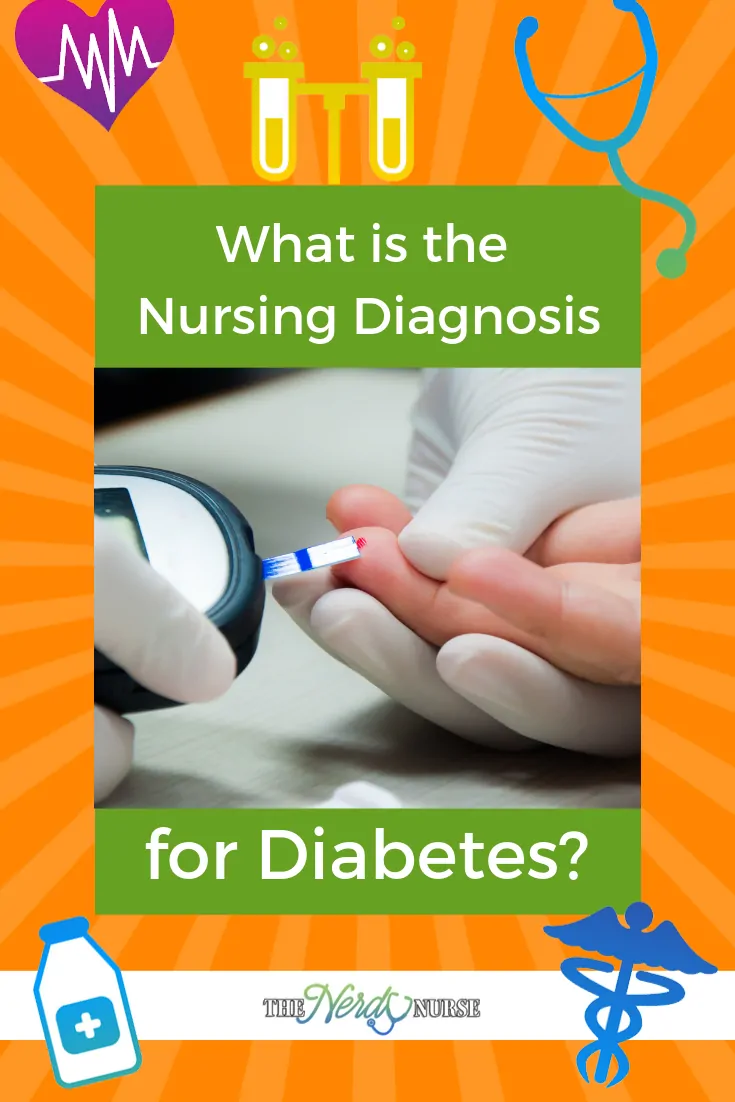Diabetes is one of the most common conditions you will come across as a nurse and carries with it many complications and considerations. When considering Nursing diagnosis for diabetes, you must understand and take these complications into account. There isn’t a single diabetes nursing diagnosis, so we’ll outline different NANDA for diabetes and issues requiring nursing interventions.
Diabetes carries many risk factors, such as elevated blood sugars, difficulty with fluid balance, difficulty with nutritional plans, skin and healing problems, and problems with sensation. While not all these diagnoses may apply to your patient, always consider other factors such as education level, history, and social supports when choosing a nursing diagnosis.
Creating a Nursing Care Plan for Diabetes
When creating a nursing care plan for diabetes you’ll need to include the following:
- Nursing diagnosis for diabetes
- Nursing interventions
- Expected Outcomes
- Evaluation
A good nursing care plan is a written version of the nursing process. For each nursing diagnosis, you might have multiple interventions and outcomes. You’ll evaluate each, instead of the diagnosis as a whole. Think of this as the problem, the proposed solution, what you think will happen, and then what actually happened. When you work on the floor you might create your nursing care plan for diabetes in your head, but if you’re in nursing school you’ll like have to write it down by hand or use a digital template.
If you struggle with writing good nursing care plans, Nursing.com has many different nursing care plan examples and even a course.
Nursing Diagnosis for Diabetes: Nutrition and Fluid Balance
The first group of possible nursing diagnoses for patients with diabetes include those involved in fluid balance and nutrition. Diabetes affects the body’s ability to control blood sugar levels in the cells, and as such even if a patient is eating sufficient calories, without a way to bring that sugar into the cells to use as energy, the body essentially starves. So we’ll dig into the diabetes nursing diagnoses that focus on nutrition and fluid imbalances.
Risk for Imbalanced Nutrition
While a patient may be ingesting sufficient calories, without a way to bring those sugars into the cells the body may not be receiving enough calories. This may be more typical for Type I or insulin-dependent diabetics.
Risk for Unstable Blood Glucose
If blood sugars are not carefully regulated in a diabetic patient, they are at risk for instability in their blood glucose levels. Many times, with poorly controlled diabetics they start to go down the blood sugar roller coaster – They get a low blood sugar, treat it with too much sugar, and then battle high blood sugars until they again are low. This can also be used for a hyperglycemia nursing diagnosis or hypoglycemia nursing diagnosis.
Risk for Deficient or Imbalanced Fluid Volume
When blood sugars rise, the body attempts to remove that excess sugar by increasing the release of fluid through excessive urination and thirst. The increase may cause the body to become dehydrated and have electrolyte imbalances. When choosing a diagnosis, you may select either deficient or imbalanced fluid volume depending on your patient’s situation.
Nursing Diagnosis for Diabetes: Skin Integrity
When nerves and blood vessels are exposed to prolonged elevated blood sugars, they may become damaged, causing diabetic neuropathy and peripheral vascular disease. These conditions may lead to an increase in wounds and infections in the body, particularly in the feet. Elevated blood sugars also affect neutrophil functioning, one of the most important white blood cells involved in fighting bacterial infections. This causes a delay and more difficulty in the healing process.
Risk for Impaired Skin Integrity
If your patient has developed peripheral neuropathy because of their diabetes, the risk for a wound or ulcer developing is significantly increased. Often patients with neuropathy have a lowered sensation of pain, and so they may not realize if they have received an injury to their feet or if a pressure ulcer is developing.
Risk for Thermal Injury
Peripheral neuropathy also affects a patient’s ability to feel high temperatures, and they are more likely to scald or burn themselves without realizing it. These burns may be slow to heal and are more likely to get infected, due to the stunting of the immune system from reduced neutrophil functioning.
Risk for Infection
Hyperglycemia impairs the ability of the immune system to fight infections and reduces the body’s defenses against skin infections. Furthermore, peripheral vascular disease impairs blood flow, which slows down healing time for ulcers and infections.
Risk for Delayed Surgical Recovery
If your patient has just undergone surgery, then this diagnosis may apply to their situation. When blood sugars are chronically elevated both the immune and circulatory systems are impaired. Without proper blood circulation, wounds are slower to heal and are more likely to get infected. Coupled with a weakened immune system, your diabetic patient may have great difficulty with wound healing and surgical recovery.
Nursing Diagnosis for Diabetes: Health Management
Diabetes is a complicated disease to manage and depending on your patients’ education level or socioeconomic status, managing and learning about their condition may be challenging.
Deficient Knowledge
If your patient has just been diagnosed with diabetes or seems to have a poor understanding of the disease process, then teaching them about the disease will be of the highest priority. Not all patients will have gone to college or even completed grade school, so they may struggle with the concepts around diabetes. Repetition and reanalysis may be required to ensure they have a complete understanding of their disease. Consider evaluating if your patients can read and try to find alternative ways of teaching if the patient seems to be struggling.
Ineffective Health Management
Diabetes can be a complicated disease to manage. Often patients become complacent with elevated blood sugars or are fearful of hypoglycemia, so they keep their blood sugar levels higher than average. Understanding the reasons why your patient is not managing their disease is as important as providing strategies. Considering strategies to help your patients managing their diabetes can be beneficial when developing a nursing care plan.
Chronic Pain
Many people with diabetes develop peripheral neuropathy and suffer from chronic pain in their hands and feet. This pain can be quite severe and difficult to manage, and may affect their quality of life and independence and may even affect their ability to walk around. Developing strategies to help your patient’s manage chronic pain can significantly affect their quality of life and future prognosis.
Diabetes is a common disease that will affect many of your patients. Understanding the appropriate nursing diagnoses will help you develop a comprehensive care plan to help your patients achieve their health goals and further their recovery from illness or surgery.
What do you think is the most common diabetes nursing diagnosis? What is the most difficult NANDA for diabetes to write a care plan for?
See also:
- How To Take Care of Both Psychological and Physical Health
- Must Know Laboratory Values for Nurses
- What is Pathophysiology & Why is it Important?
- Nursing Interventions for Acute and Chronic Pain Management
- NANDA: Nursing Diagnosis List
Bright Spots & Landmines: The Diabetes Guide I Wish Someone Had Handed Me



What is diabetes mellitus?
Diabetes mellitus refers to u003ca href=u0022https://www.mayoclinic.org/diseases-conditions/diabetes/symptoms-causes/syc-20371444u0022 target=u0022_blanku0022 rel=u0022noopeneru0022 aria-label=u0022diseases focused on how your body interacts with glucose (opens in a new tab)u0022u003ediseases focused on how your body interacts with glucoseu003c/au003e, produces insulin, and converts it into energy for your body to use.
What is the difference between diabetes and diabetes mellitus?
Typically, when someone refers to diabetes they are referring to diabetes mellitus. However, diabetes insipidus is related to how your kidney’s function. Diabetes is the simplified version of the disease name most commonly used in routine speech and even by medical professionals.
Is a diabetes mellitus nursing diagnosis different from a diabetes nursing diagnosis?
No. Since diabetes mellitus is often shortened to diabetes, they are absolutely the same.
Is the nursing diagnosis for type 2 diabetes the same as the nursing diagnosis for diabetes?
Yes. They are the same diagnosis and have the same treatment plan.
What is a common diabetes NANDA?
There are many nursing diabetes NANDAs. They can be grouped by skin integrity, health management, and nutrition and fluid balance.











My students are having a hard time relating their nursing diagnosis with their desired outcomes and connecting them with the nursing interventions and responses. You got any suggestions? .Thanks